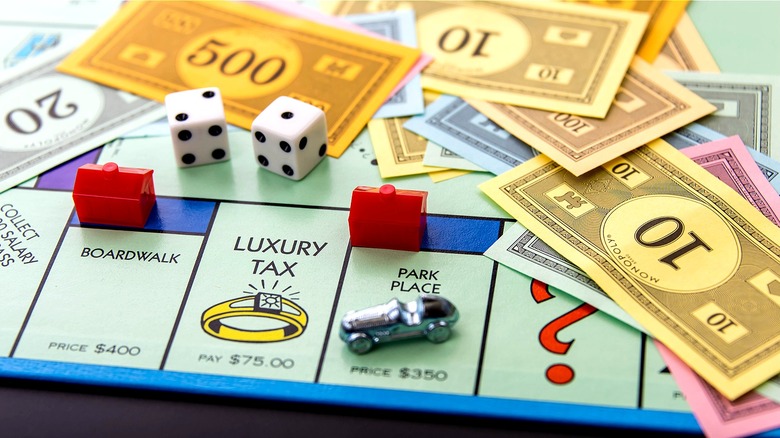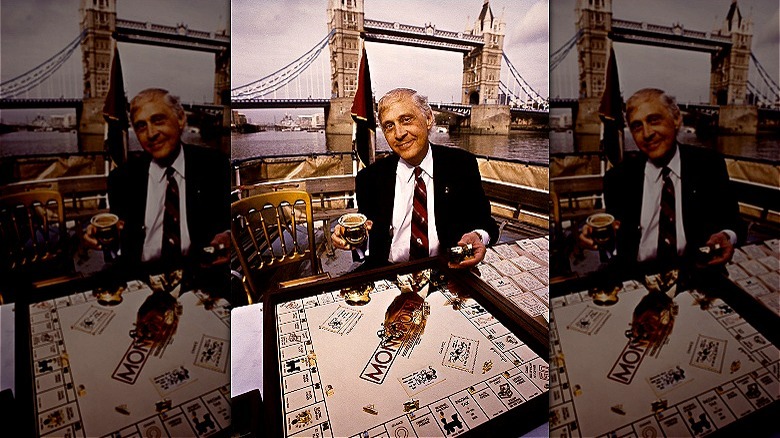The Most Valuable Monopoly Board Game Ever Made
There's a lot of money in board games. It's become a billion-dollar industry. And why not? Board games are a great way to pass the time with friends and family, and some have enough complexity and replay value to provide hours of diversion for many nights. If the price tags on some games seem high, it's worth remembering that designing a game, like, say, Hasbro's Monopoly, and making hardy pieces for it demands a lot of time, effort, money, and art. Some amazing paintings, drawings, and graphics have been rendered for board games over the years.
Monopoly isn't as complex or, in its standard edition, as elaborate as other board games out there. The standard edition of the game, with its foldout board, colorful money, and simple game pieces, goes for around $20. For critics who have dismissed Monopoly as a board game, that might still be too much. But Monopoly remains an iconic game, one that Hasbro has issued in myriad editions. Monopoly's Luxury variant of wood, leather, and gold foil goes for almost $300.
But there is an even pricier Monopoly set, and by a lot, too. The game, named for dominance in an economic sphere (read about the pros and cons of a monopoly market), inspired artist Sidney Mobell to make a Monopoly set that would be an extravagant piece of art. His game board, made of jewels and precious metals, was valued at $2 million when it was finished.
The creator of the $2-million Monopoly set
Sidney Mobell's calling card as an artist might best be described as bejeweling the ordinary. A San Francisco-based jeweler, Mobell decided that the best way to outflank the competition was to offer something unique. One of his first attempts was creating a solid-gold replica of a common Mickey Mouse watch; this led to a commission for Walt Disney's brother Roy.
After that, Mobell became known for his priceless takes on everyday items. His creations became advertising for his store, and his list of celebrity clients grew, including Charles Schulz of "Peanuts" fame (who also commissioned a watch) and fast-food pioneer Ray Kroc (whose wife Joan bought him one of five golden Mobell mousetraps for his birthday). Other Mobell projects were done on his own whim, such as a sardine can made of 18-karat gold and featuring diamond-studded chocolate sardines.
Mobell told Smithsonian Magazine that his $2-million Monopoly board stemmed from an offer he made to Hasbro. "I contacted them," he said. "And they said, 'if you can make the thing exactly like our $30 Monopoly board, we'll send you to London and that'll be the feature item.'" The occasion was the World Monopoly Tournament of 1988, held in London that year.
The Monopoly set is made of gold
Sidney Mobell's Monopoly replica has a board plated with 23-karat gold, and gold is the primary material of the entire set. The money is gold paper, the play pieces are solid 18-karat gold, and the dice and houses are also made of gold. The latter pieces are augmented with jewels; the dice have diamond studs representing their numerical value, while the game's houses have rubies and sapphires embedded in their chimneys. The jewels were one step up from another Mobell foray into board games, a gold-only chess set.
Mobell credited his $2-million Monopoly board with making him an international name. He told Smithsonian Magazine, "When I got [to London for the World Monopoly Tournament], the news hit, and it was picked up in every television station. All of a sudden I had become famous." Mobell later donated the game set, along with 19 other pieces, to the Smithsonian, and they became a featured show at the institution's National Museum of Natural History.

